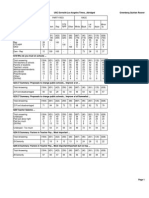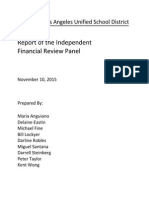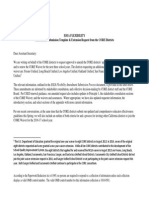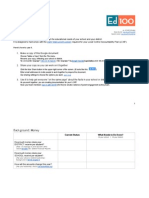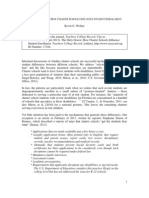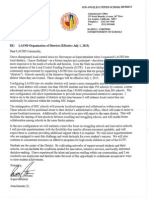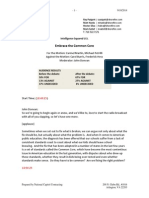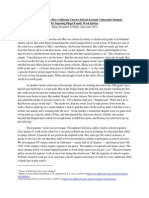Professional Documents
Culture Documents
LAUSD Bulletin 963
Uploaded by
smf 4LAKids0 ratings0% found this document useful (0 votes)
440 views7 pagesThis bulletin replaces Bulletin No. Z-52, of the same subject, dated August 4, 1998. Heat stress is the overall effect of excessive heat on the human body. Those at highest risk are the very young, the elderly, people with acute or chronic health problems.
Original Description:
Copyright
© Attribution Non-Commercial (BY-NC)
Available Formats
PDF, TXT or read online from Scribd
Share this document
Did you find this document useful?
Is this content inappropriate?
Report this DocumentThis bulletin replaces Bulletin No. Z-52, of the same subject, dated August 4, 1998. Heat stress is the overall effect of excessive heat on the human body. Those at highest risk are the very young, the elderly, people with acute or chronic health problems.
Copyright:
Attribution Non-Commercial (BY-NC)
Available Formats
Download as PDF, TXT or read online from Scribd
0 ratings0% found this document useful (0 votes)
440 views7 pagesLAUSD Bulletin 963
Uploaded by
smf 4LAKidsThis bulletin replaces Bulletin No. Z-52, of the same subject, dated August 4, 1998. Heat stress is the overall effect of excessive heat on the human body. Those at highest risk are the very young, the elderly, people with acute or chronic health problems.
Copyright:
Attribution Non-Commercial (BY-NC)
Available Formats
Download as PDF, TXT or read online from Scribd
You are on page 1of 7
Los ANGELES UNIFIED SCHOOl ..
DISTRICT POLICY BULLETIN
TITLE:
GUIDELINES FOR PREVENTING HEAT STRESS
ROUTING
All Employees All Locations
ISSUER:
Maria Reza, Assistant Superintendent Student Health and Human Services
NUMBER:
BUL-963
DATE:
April 1, 2004
POLICY:
To counteract heat stress, all District personnel must pay attention to weather conditions and use common sense and good judgment for modifying activities and/or school days.
This bulletin replaces Bulletin No. Z-52, of the same subject, issued by Student Health and Human Services, dated August 4, 1998. The content has been updated to conform to the new format for written communications
MAJOR CHANGES:
GUIDELINES: The following guidelines apply.
I. Introduction
Heat stress is .the overall effect of excessive heat on the human body. Prolonged exposure to high air temperatures or to high humidity at even more moderate temperatures may cause the body temperatures of people of all ages to rise and produce one or more ofthe signs of heat stress affecting the ability to learn, work, or even play.
Those at highest risk are the very young, the elderly, people with acute or chronic health problems, and people using certain medication or taking illicit drugs. For various reasons, not aU people tolerate heat to the same extent.
To counteract heat stress, all District personnel must pay attention to these contributior factors:
• air temperature
• humidity
• air circulation
• radiant heat
• air pollution
• classroom temperature
• classroom location
• medical problems and use of medications
• fluid intake
• appropriate clothing
• physical conditioning
•
acclimation to heat
intensity, type and duration of exercise
•
COMMON SENSE AND GOOD JUDGMENT MUST AL WAYS BE APPLIED BY STAFF WHEN ANAL YZING SITE CONDITIONS Policy Bulletin No. BUL-963 Student Health and Human Services
Page 1 of7
April 1, 2004
LOs ANGELES UNIlrIED SCHOOL DISTRICT POLICY BULLETIN
IL Weather Conditions For Modifying Activities Or School Day
Authorities in the fields of medicine, environmental and occupational hazards, and safety have thoroughly studied heat stress and have issued guidelines pertaining to modifying physical activity and school or work schedules. It is recommended that temperature and humidity readings be obtained from the National Weather Bureau, (805) 988-6614. Readings for local areas may be obtained by contacting the appropriate District/UnitIDivision Office. Local news reports on radio and television also carry this information.
The following chart provides guidelines for consideration in modifying instructional programs, physical activity, and school schedules:
'" AIr pollution alerts MUST be obeyed mall categones . **Ifair circulation (or wind velocity) is 10 mph or greater, the effects of temperature may be less severe.
Policy Bulletin No. BUL~963 Student Health and Human Services
SUGGESTED ACTION
Temp. Possible Heat Humidity less Humidity 50%
Catee;ory '" (FD) Stress Effects than 50% or 2reater
Normal 82° or -Good learning -Regular school .oRegular school day.
less conditions. day
No effect.
Alert 82°_92° -Leaming -Regular school -Regular school day.
may decrease day. -Limit duration &
with long -If near 50% intensity of or
exposure. humidity ,limit modify physical
• Fatigue may intensity of or activity & monitor
increase after modify physical closely.
4-6 hours. activity and
monitoring,
Caution 92°_ ·Early heat -Regular school -Regular school day
95°*'" stress and day. -Limit duration &
cramps -Limit duration intensity of &
possible. & intensity of modify physical
-Heat or modify activity & monitor
exhaustion physical activity closely.
or heat stroke & monitor-
possible with closely.
long exposure.
Extreme 95° or -Heat stroke or -Consider -Consider schedule
Caution above"'''' heat schedule change. change.
exhaustion -Prohibit or limit -Prohibit physical
possible. duration & activity.
intensity of,
modify physical
activity, &
monitor closely_.
. Page 2 of7
April 1, 2004
Los ANGELES UNIl:,'ffin SCHOOL DISTRICT POLICY BULLETIN
PLEASE NOTE:
STUDENTS WITH CERTAlN HEALTH PROBLEMS MAY REQUIRE MORE ATTENTION. IF STUDENTS COMPLAIN ABOUT THE HEAT, ALLOW THEM TO REST OR SEE THE SCHOOL NURSE WHO MAY WANT TO HA VB THEIR HEALTH STATUS CLARIFIED BY A PARENT OR GUARDIAN.
EMPLOYEES WITH SPECIFIC HEALTH PROBLEMS SHOULD MAKE THEM KNOWN TO SITE ADMINISTRATORS.
In. Procedures For Conducting Classroom Activities
On very hot, humid days, administrators, teachers, and other staff should be aware of the following procedures to help minimize possible heat stress.
A. Faculty and staff must be informed at the beginning of each semester/track, and as needed thereafter, about the school's program for preventing heat stress and the most efficient methods for reducing heat and maximizing ventilation in classrooms.
B. Doors and windows must be closed in air-conditioned rooms, and any airconditioning equipment malfunction should be reported at once.
C. When possible, all air-conditioned rooms should be used as classrooms.
D. Non-air conditioned classrooms should be surveyed by teacher or principal's designee when temperatures require that maximum cooling efforts be instituted, including:
• Windows, doors, transoms, and venetian blinds should be adjusted for maximum ventilation and air circulation.
• Electric fans, where available, should be placed to bring in fresh air and exhaust stale air rather than just blowing it around the room. Fans should be placed in or next to an open window at one end of the room to bring in air, and a window or door (not one that opens into a hall) at the opposite end of the room should be opened to exhaust air. For rooms with unusual heat problems, installing an electric fan in one window or transom and covering the opening with a security screen should be considered. Fans should be turned on as early as possible.
• Adjusting custodial hours should be considered to permit early entry into classrooms to open doors, windows, transoms, and turn on fans.
• Precautions should be taken to ensure that when fans, coolers, or other devices are used they meet safety standards and that cooling strategies do not place an overload on existing electrical systems.
Policy Bulletin No. BUL·963 Student Health and Human Services
Page 3 of?
Aprill,2oo4
Los ANGELES UNIFIED SCHOOL DISTRIOT POLICY BULLETIN
E. When classroom temperatures exceed 92°, consideration should be given to moving students to cooler rooms or other appropriate areas, such as the auditorium, multipurpose room, library, or shaded outdoor areas. When possible, classes should be combined in air-conditioned rooms.
F. Teachers, especially at the elementary level, may adjust their programs to use the cooler early hours for physical activity.
G. Water must be available. Personal water containers are recommended for use when heat is excessive as a means to prevent dehydration. Use at other times should be a local school option. School sites and secondary physical education departments should establish policies for use of water containers and inform students and parents.
A personal water container is a firm, non-breakable plastic receptacle which is no more than 9" high and 4" wide that will hold no more than 32 ounces of water. The container may have a pressure seal, screw or popup cap, or a straw drink device on its top. The use of an other types of personal water containers is prohibited. The following are recommended precautions:
• For health reasons, water containers should not be shared.
• For safety reasons, students should not run with straws or containers in mouth.
• For safety reasons, containers may not be used while riding District buses.
• Students should not bring containers to physical education activity areas unless given permission by the physical education teacher.
H. Staff and all personnel supervising physical activities, including Youth Services personnel, should observe students during activity periods and modify activities as recommended in Section II. Students known to have health problems should be closely observed and their activity modified or restricted.
IV. Precautions For Outdoor Activities
During times of excessive heat, the following precautions need to be taken for outdoor physical activity which includes recess, physical education, recreation, and competitive sports:
A. The intensity of exercise activities must be limited or they must be modified whenever air temperature and humidity are above caution levels (refer to Section II).
Policy Bulletin No. BUL~963 Student Health and Human Services
Page 4 of?
April 1, 2004
Los ANGELES UNIFIED SCHOOL DISTRICT POLICY BULLETIN
B. Smog alert warnings must be obeyed. See the most recent Reference Guide issued by the Office of Environmental Health and Safety titled "Health Advisory/Air Pollution Episodes and Procedures."
C. Adequate water must be available. If adequate water is not available, physical activity must be modified. Prior to prolonged physical activity, a person should be fully hydrated. During the activity, periodic drinking of water every 15 to 30 minutes should be encouraged. Use of salt tablets is not advised, and commercially available replacement fluids for athletes are not usually necessary. Sugary and alcoholic beverages cause dehydration. Carbonated beverages may cause abdominal pain.
Ifwater fountains are not located near the place of activity, large urns from the cafeteria may be filled with water and placed in strategic locations.
D. Proper clothing should reflect heat, permit freedom of movement,and allow free perspiration. Clothing should be light colored, lightweight, loose, and limited to one layer of absorbent material in order to facilitate evaporation of sweat and expose as much skin as possible, yet still be appropriate for the school environment.
Sweat-saturated garments should be replaced by dry ones. Rubberized sweat suits should never be used to produce loss of weight. Sunscreen, proper clothing, and hats should be used to prevent sunburn.
E. Staff and all personnel supervising physical activities, including Youth Services personnel, should observe students during activity periods and modify activities as recommended in Section II. Students known to have health problems should be closely observed and their activity modified or restricted.
F. Teachers must observe students closely and know signs and symptoms of heat stress, emergency first aid, and how to obtain medical help. (See Attachment A)
G. The intensity and duration of a strenuous exercise program should be adjusted initially for students who are not acclimated to the climate. The intensity and duration of the program can then be gradually increased over a period of 10 to 14 days to allow the students to adapt to the effects of heat.
Policy Bulletin No. BUL-963 Student Health and Human Services
Page 5 of7
April 1, 2004
J_JOS ANGELES IJNIFIED SCHOOL DISTRICT POLICY BULI~ETIN
H. Marked differences between indoor and outdoor temperatures may precipitate physical problems.
I. Secondary and adapted physical education teachers should modify the type, duration, and intensity of exercise. For suggestions refer to "Inclement Weather Program" in the Secondary Physical Education Curriculum, Grade 6-12, Publication No. SC-957. 1990, page 49 or the appropriate elementary guide.
J. Rest periods should be provided during activity.
K. Activities must be followed by the proper cool-down (for example, jogging should be followed by walking) and rest.
L Athletes engaging in competitive sports must have their activities closely observed for aU of the above considerations.
M. Other strenuous student activities-such as drill team, marching band, cheerleading, and the like--must be closely observed by teachers, coaches, and other certificated personnel assigned to supervise such activities.
V. Additional Strategies For Preventing Heat Stress
A. The contents of this bulletin should be reviewed annually and as otherwise needed. Teachers, staff, parents, and students should be instructed by school nurses regarding awareness of signs and symptoms and first aid for problems attributable to excessive heat. Teachers should explain precautions to students. Information on heat stress (see Attachment A) should be sent home to parents.
B. A "cool room" should be established for use by students showing early signs of heat stress. This room should provide maximum coolness possible. During an emergency, if an air-conditioned classroom is to be used as a "cool room"and is occupied by students, the students should be moved to another location. During excessive heat the "cool room" should be available for use at all times during the school day.
If possible, the "cool room" should be located near restrooms and should be equipped with chairs, cots, or mats; running water or adequate amounts of cool dispensed water; telephone or functioning communication with the main office; refrigerator or ice chest with ice and cold compresses; and basic first aid supplies. It should be supervised by staff trained to recognize signs and symptoms of heat stress and administer first aid.
Policy Bulletin No. BUL-963 Student Health and Human. Services
Page 60f7
April i, 2004
Los ANGELES UNIFIED SCHOOL DISTRICT POLICY BUJ .... LETIN
Students showing any signs of heat stress should be cared for using the guidelines in Attachment A
C. Prior to boarding buses, traveling students should be encouraged to drink water and be given time to drink: cool water located near the pickup areas. For safety reasons, personal water containers may not be used while riding District buses. When the temperature is 95° or hotter and the humidity is 50% or greater, schools may consider providing large moist towelettes for use by students without intervention by the driver.
References:
Data used in this bulletin was adapted in part from:
1. American Academy of Pediatrics, Committee on School Health, "Heat Stress and School Closings,"Pediatri.cs, Vol. 74, No.2, 1984
2. American Academy of Pediatrics, Committee on Sports Medicine, "Climati Heat Stress and the Exercising Child and Adolescent," Pediatrics. Vol. 10 No. I, July 2000.
AUfHORITY: This is a policy of the office of the Assistant Superintendent, Student Health and Human Services.
ASSISTANCE: For assistance or further information please contact the Director, Student Medical Services at (213) 765-2830; or Barbara Fiege, Director, Interscholastic Athletics, at (213) 207-2200.
Policy Bulletin No. BUL-963 Student Health and Human Services
Page 7 of7
April 1, 2004
You might also like
- Policy BriefDocument9 pagesPolicy Briefsmf 4LAKidsNo ratings yet
- LAUSD Charter School Effect Study 050916Document46 pagesLAUSD Charter School Effect Study 050916smf 4LAKidsNo ratings yet
- Spring Semester A-G Monitoring PlanDocument4 pagesSpring Semester A-G Monitoring Plansmf 4LAKidsNo ratings yet
- 01 26 16StateLegislativeBudgetUpdateDocument8 pages01 26 16StateLegislativeBudgetUpdatesmf 4LAKidsNo ratings yet
- USC LA Times Sat CrosstabsDocument48 pagesUSC LA Times Sat Crosstabssmf 4LAKidsNo ratings yet
- LAUSD INDEPENDENT FINANCIAL REVIEW PANEL Final Report Nov. 2, 2015Document75 pagesLAUSD INDEPENDENT FINANCIAL REVIEW PANEL Final Report Nov. 2, 2015smf 4LAKidsNo ratings yet
- LAUSD Independent Financial Review Panel - Meeting Materials As of 23 Oct 2015Document260 pagesLAUSD Independent Financial Review Panel - Meeting Materials As of 23 Oct 2015smf 4LAKidsNo ratings yet
- S&P: California Initiates Budget Process Amid Rising Stock Market VolatilityCA Budget StockMarketVolatility 1-25-2016Document7 pagesS&P: California Initiates Budget Process Amid Rising Stock Market VolatilityCA Budget StockMarketVolatility 1-25-2016smf 4LAKidsNo ratings yet
- 01 25 16FederalLegislativeUpdateDocument39 pages01 25 16FederalLegislativeUpdatesmf 4LAKidsNo ratings yet
- 2016 AccaDeca Vol AppDocument3 pages2016 AccaDeca Vol Appsmf 4LAKidsNo ratings yet
- Westchester Secondary Charter v. LAUSD (B261234, 6-19-15)Document25 pagesWestchester Secondary Charter v. LAUSD (B261234, 6-19-15)smf 4LAKidsNo ratings yet
- USC LA Times Sat Topline QuestionnaireDocument10 pagesUSC LA Times Sat Topline Questionnairesmf 4LAKidsNo ratings yet
- Los Angeles Unified School District: Board of Education ReportDocument14 pagesLos Angeles Unified School District: Board of Education Reportsmf 4LAKidsNo ratings yet
- White Paper: INDIVIDALIZED LEARNING PLANSDocument29 pagesWhite Paper: INDIVIDALIZED LEARNING PLANSsmf 4LAKidsNo ratings yet
- Independent Financial Review Panel - Memo To The Board 11-3-2015Document1 pageIndependent Financial Review Panel - Memo To The Board 11-3-2015smf 4LAKidsNo ratings yet
- The 2015-16 Budget: Possible May Revision ScenariosDocument20 pagesThe 2015-16 Budget: Possible May Revision Scenariossmf 4LAKidsNo ratings yet
- CORE 2014-15 Amendments - March Renewal Request (V Release To USED 3.31.15)Document12 pagesCORE 2014-15 Amendments - March Renewal Request (V Release To USED 3.31.15)smf 4LAKidsNo ratings yet
- 04 09 15BFABudgetUpdateLAODocument27 pages04 09 15BFABudgetUpdateLAOsmf 4LAKidsNo ratings yet
- A Matter of Equity: Preschool in AmericaDocument15 pagesA Matter of Equity: Preschool in Americasmf 4LAKidsNo ratings yet
- L Cap Checklist For ParentsDocument8 pagesL Cap Checklist For Parentssmf 4LAKidsNo ratings yet
- NEA Rankings and Estimates-2015!03!11aDocument130 pagesNEA Rankings and Estimates-2015!03!11aNC Policy WatchNo ratings yet
- LAUSD/USDOE Recommendations Tracking - 3-20-15Document8 pagesLAUSD/USDOE Recommendations Tracking - 3-20-15smf 4LAKidsNo ratings yet
- Welner Charter Enrollment Teachers College RecordDocument7 pagesWelner Charter Enrollment Teachers College RecordNational Education Policy CenterNo ratings yet
- LAUSD Organization of Districts (Effective July 1, 2015)Document12 pagesLAUSD Organization of Districts (Effective July 1, 2015)smf 4LAKidsNo ratings yet
- BOC LAUSD IT Presentations 10 30 14.ppsxDocument29 pagesBOC LAUSD IT Presentations 10 30 14.ppsxsmf 4LAKidsNo ratings yet
- LAUSD Office of The Inspector General Special Contract Audit Review of MiSiSProjectDocument19 pagesLAUSD Office of The Inspector General Special Contract Audit Review of MiSiSProjectsmf 4LAKidsNo ratings yet
- Intelligence Squared Common Core Debate TranscriptDocument55 pagesIntelligence Squared Common Core Debate Transcriptsmf 4LAKidsNo ratings yet
- Charging For Access: How California Charter Schools Exclude Vulnerable Students by Imposing Illegal Family Work QuotasDocument77 pagesCharging For Access: How California Charter Schools Exclude Vulnerable Students by Imposing Illegal Family Work Quotassmf 4LAKidsNo ratings yet
- Cruz Vs State of CA RG14727139 TRODocument14 pagesCruz Vs State of CA RG14727139 TROsmf 4LAKidsNo ratings yet
- Deasy/L.A. Unified Separation AgreementDocument6 pagesDeasy/L.A. Unified Separation AgreementSouthern California Public RadioNo ratings yet
- Shoe Dog: A Memoir by the Creator of NikeFrom EverandShoe Dog: A Memoir by the Creator of NikeRating: 4.5 out of 5 stars4.5/5 (537)
- Never Split the Difference: Negotiating As If Your Life Depended On ItFrom EverandNever Split the Difference: Negotiating As If Your Life Depended On ItRating: 4.5 out of 5 stars4.5/5 (838)
- Elon Musk: Tesla, SpaceX, and the Quest for a Fantastic FutureFrom EverandElon Musk: Tesla, SpaceX, and the Quest for a Fantastic FutureRating: 4.5 out of 5 stars4.5/5 (474)
- The Subtle Art of Not Giving a F*ck: A Counterintuitive Approach to Living a Good LifeFrom EverandThe Subtle Art of Not Giving a F*ck: A Counterintuitive Approach to Living a Good LifeRating: 4 out of 5 stars4/5 (5783)
- Grit: The Power of Passion and PerseveranceFrom EverandGrit: The Power of Passion and PerseveranceRating: 4 out of 5 stars4/5 (587)
- Hidden Figures: The American Dream and the Untold Story of the Black Women Mathematicians Who Helped Win the Space RaceFrom EverandHidden Figures: The American Dream and the Untold Story of the Black Women Mathematicians Who Helped Win the Space RaceRating: 4 out of 5 stars4/5 (890)
- The Yellow House: A Memoir (2019 National Book Award Winner)From EverandThe Yellow House: A Memoir (2019 National Book Award Winner)Rating: 4 out of 5 stars4/5 (98)
- On Fire: The (Burning) Case for a Green New DealFrom EverandOn Fire: The (Burning) Case for a Green New DealRating: 4 out of 5 stars4/5 (72)
- The Little Book of Hygge: Danish Secrets to Happy LivingFrom EverandThe Little Book of Hygge: Danish Secrets to Happy LivingRating: 3.5 out of 5 stars3.5/5 (399)
- A Heartbreaking Work Of Staggering Genius: A Memoir Based on a True StoryFrom EverandA Heartbreaking Work Of Staggering Genius: A Memoir Based on a True StoryRating: 3.5 out of 5 stars3.5/5 (231)
- Team of Rivals: The Political Genius of Abraham LincolnFrom EverandTeam of Rivals: The Political Genius of Abraham LincolnRating: 4.5 out of 5 stars4.5/5 (234)
- Devil in the Grove: Thurgood Marshall, the Groveland Boys, and the Dawn of a New AmericaFrom EverandDevil in the Grove: Thurgood Marshall, the Groveland Boys, and the Dawn of a New AmericaRating: 4.5 out of 5 stars4.5/5 (265)
- The Hard Thing About Hard Things: Building a Business When There Are No Easy AnswersFrom EverandThe Hard Thing About Hard Things: Building a Business When There Are No Easy AnswersRating: 4.5 out of 5 stars4.5/5 (344)
- The Emperor of All Maladies: A Biography of CancerFrom EverandThe Emperor of All Maladies: A Biography of CancerRating: 4.5 out of 5 stars4.5/5 (271)
- The World Is Flat 3.0: A Brief History of the Twenty-first CenturyFrom EverandThe World Is Flat 3.0: A Brief History of the Twenty-first CenturyRating: 3.5 out of 5 stars3.5/5 (2219)
- The Unwinding: An Inner History of the New AmericaFrom EverandThe Unwinding: An Inner History of the New AmericaRating: 4 out of 5 stars4/5 (45)
- The Gifts of Imperfection: Let Go of Who You Think You're Supposed to Be and Embrace Who You AreFrom EverandThe Gifts of Imperfection: Let Go of Who You Think You're Supposed to Be and Embrace Who You AreRating: 4 out of 5 stars4/5 (1090)
- The Sympathizer: A Novel (Pulitzer Prize for Fiction)From EverandThe Sympathizer: A Novel (Pulitzer Prize for Fiction)Rating: 4.5 out of 5 stars4.5/5 (119)
- Her Body and Other Parties: StoriesFrom EverandHer Body and Other Parties: StoriesRating: 4 out of 5 stars4/5 (821)




